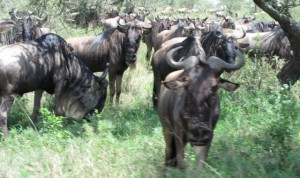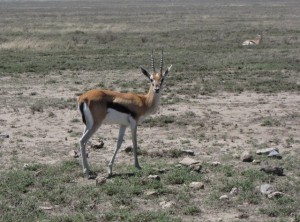Birds
There are so many birds here. Bland black and white ones with a 6 song repertoire, colorful orange and blue one, big ones, small ones, fast ones, slow ones, ground bound ones and ones that soar with the clouds. Some even try to steal Debbie’s chicken right out of her hands. They all, of course, have their individual calls, and they are so different from the ones we know. Some of the calls are very complicated, quite long with a wide variety of notes. They start singing at 5 am as soon as the light breaks the horizon and are quiet by 6 pm when the sun sets.
Heat
It is hot here in the Serengeti. Hot, every day. 30 C or more, but we are actually quite comfortable. The air is quite dry so the heat is similar to the prairies. There is also a fairly constant breeze which has a great cooling effect. Again, similar to home. Today the breeze abated and the heat was much more noticeable, but still bearable.
Garbage
The national parks and conservation areas are spotless. I have seen 1, exactly ONE, plastic bottle on the road. No garbage in the ditch and nothing at any of the picnic sites. Even in Arusha, a small city, there is not much garbage on the streets. If all of Tanzania is like this, it is an impressive accomplishment.
Bugs
OMG. There are bugs here. Imagine any bug and you can find it here. This morning, I played with a mini grasshopper about the size of a dime. I touch its back knee and it jumps across the breakfast table. I couldn’t begin to describe the kinds of bugs we have run into but spiders, tse tse flies, flies, beetles, flying bugs, crawling bugs and maybe THREE mosquitos are but a few. Malaria? I’m sure the numbers of mosquitos can be bad, but right now I do not know why we spent hundreds of dollars on malaria meds. My cynical self wonders how much input the drug companies have in recommending what areas require prophylactics and what areas don’t. The ordinary house flies here are terrible. They get worse as the migration brings more animals to the area. A sweep of the hand does not seem to be a threat to them. They pester and pester and pester. Flies here need to take lessons from their North American cousins.
Facilities
The facilities here are world class. There have been a couple of questionable washrooms but that is the case anywhere in the world. The tourist info centers, although simple, are well constructed, maintained and informative. The lodges and camps are well located yet unobtrusive and are not visible until you are upon them. All but the fussiest people can travel here and feel comfortable.
Sounds
Africa is a whole new symphony to our ears. The cars in the city do not use their horns incessantly as they do in Asia. Except for the sounds of the auto, the city is quite quiet.
The wilderness is a whole different world. I can ski up to the top of a mountain in Banff National Park and still hear the sounds of the highway thousands of meters below. Here when our Landcruisers engine is shut off there is no noise but the wind. In the day the animals are quiet, even the birds stop tweeting. We have heard grunting sounds from the elephants. Within a gigantic herd of wildebeests, we listen to snorts.
The hippos blow bubbles while breathing and grumble about this or that.
But most of the time the animals are silent. Mornings and evenings, the birds sing and the landscape comes alive with sound. Quite peaceful, really.
Sun
We are near the equator so the sun is intense. We climb to 3,000M on Mt. Makarot and even though I am quite tanned, my arms are pink. Debbie has sunscreen on but her nose, cheeks and throat have a slight glow.
People
I cannot get over the people here. I know I am a tourist and by default a guest (wanted or unwanted) but everyone is polite, helpful and happy. There are bad people everywhere and I hope I am not being lulled into a sense of security, but the folks here are great. The four of us have come to a consensus that the Tanzanians are kind. It is the best word we can come up with, but it is an accurate one.
Migration
Four animals take part in the great migration – wildebeests, elands, zebras and Thompson Gazelles.
It starts moving south during the short rains (Nov, Dec) and goes north after the long rains in June. Today (Nov 14) we drive though a herd of wildebeests and zebra. It is massive, there are animals 50 deep and a kilometer long. This group is the leading edge of the migration and is small. Parked mid herd listening to the snorting and baying with the ground all around us moving with the animals is something to remember.
Kopje
Kopjes are outcroppings of solidified lava. The molten rock bubbled up during times of volcanic activity. The entire area was covered with ash and soil over time. The soft layers eroded away leaving the flat Serengeti landscape dotted with little bumps, kopje.
Flora
For all the fauna we see and learn about, the flora side of the scale is a little lacking in the Serengeti. We now know about the acacia tree. You would call it an umbrella tree. There are 13 types of acacia trees and 7 types of acacia bushes. I think it is a symbol of Tanzania, if not Africa. Every so often we spot a flower sitting alone on the plain. It is called a crinum lily and is my favorite.



